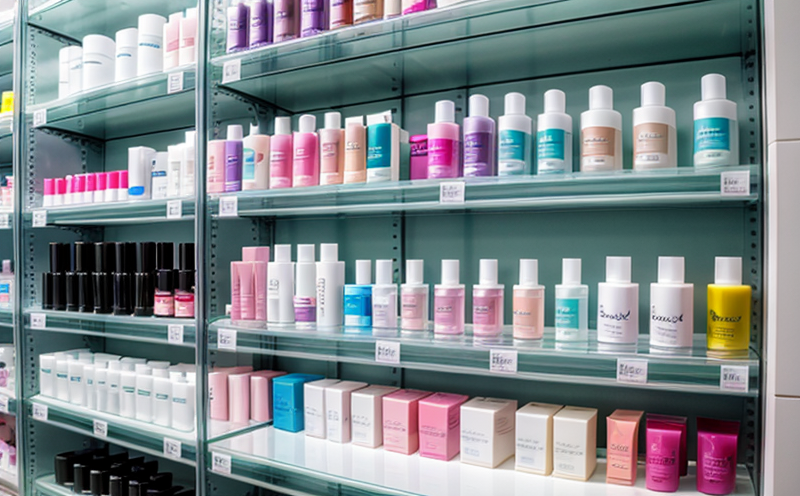Lipid Oxidation Shelf Life Testing in Cosmetics
The shelf life of cosmetic products is a critical factor that affects both consumer satisfaction and regulatory compliance. Lipid oxidation plays a pivotal role in determining the stability and longevity of formulations containing fatty acids, triglycerides, or other lipids. This process, often accelerated by light, heat, and oxygen exposure, can lead to rancidity and loss of product quality.
Our laboratory specializes in lipid oxidation shelf life testing for cosmetics, employing advanced analytical techniques such as Peroxide Value (PV), Iodine Value (IV), and Thiobarbituric Acid Reactive Substances (TBARS) assays. These methods allow us to quantify the extent of lipid peroxidation at various stages of product exposure.
For our clients in the cosmetics sector, this testing is essential for ensuring that products meet quality standards and regulatory requirements. By predicting the shelf life based on lipid oxidation rates, manufacturers can optimize formulation stability, extend product longevity, and maintain brand integrity.
The test involves subjecting cosmetic samples to controlled environmental conditions that simulate real-world storage scenarios. This includes exposure to air, light, heat, and humidity over predefined periods. We then analyze the samples using a combination of spectroscopic techniques and chromatography for accurate measurement of oxidation by-products.
Our laboratory adheres strictly to international standards such as ISO 25012 and ASTM D6978, ensuring that our test results are reliable and internationally recognized. This consistency is crucial for clients seeking compliance with global regulations.
Benefits
The benefits of lipid oxidation shelf life testing extend beyond mere compliance; they enhance the overall quality and longevity of cosmetic products. By identifying the onset of lipid peroxidation, manufacturers can take proactive measures to improve product stability and extend shelf life.
- Enhanced Product Quality: By preventing rancidity and other signs of degradation, our tests ensure that cosmetics retain their original color, texture, and aroma for longer periods.
- Improved Consumer Satisfaction: Products that remain stable over time are more likely to meet consumer expectations and maintain brand loyalty.
- Compliance with Regulations: Our testing aligns with international standards such as ISO 25012 and ASTM D6978, ensuring that products comply with global regulatory requirements.
Moreover, these tests provide valuable insights into the formulation's stability, helping R&D teams refine their processes for future product development. By understanding the factors contributing to lipid oxidation, manufacturers can optimize ingredients and packaging to improve shelf life further.
Customer Impact and Satisfaction
The impact of our lipid oxidation shelf life testing is profound and directly contributes to customer satisfaction and loyalty. When consumers purchase cosmetics that meet their expectations in terms of quality and longevity, they are more likely to recommend these products to others.
For our clients—quality managers, compliance officers, R&D engineers, and procurement teams—the ability to predict shelf life accurately translates into better decision-making. By leveraging our testing services, these professionals can ensure that their products not only meet but exceed consumer expectations while remaining compliant with regulatory standards.
The data generated from our tests allows for informed decisions regarding formulation adjustments, packaging design, and storage conditions. This proactive approach ensures that cosmetic products remain at peak quality throughout their shelf life, thereby enhancing customer satisfaction and trust in the brand.
Competitive Advantage and Market Impact
The competitive advantage derived from accurate lipid oxidation shelf life testing is significant. By being able to predict and optimize product stability, manufacturers can gain a strategic edge over competitors who may not have access to such advanced testing capabilities.
- Market Differentiation: Products with extended shelf lives are more attractive to consumers, leading to higher sales and market share.
- Innovation Leadership: Understanding the mechanisms of lipid oxidation allows manufacturers to innovate and develop new formulations that can withstand harsher conditions.
- Regulatory Compliance: Adherence to international standards ensures compliance with regulations, which is increasingly important in a globalized market.
In terms of market impact, our testing services contribute to the overall quality and integrity of the cosmetic industry. By promoting best practices in formulation and packaging design, we help ensure that consumers receive high-quality products consistently across brands. This not only enhances consumer trust but also fosters a healthier and more sustainable cosmetics industry.





